人教版-选修7unit2-robots教案
- 格式:doc
- 大小:41.50 KB
- 文档页数:4
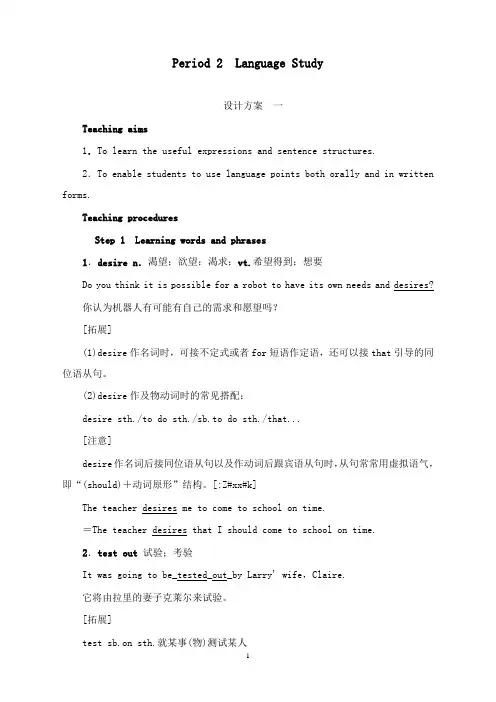
Period 2 Language StudyTeaching aims1.To learn the useful expressions and sentence structures.2.To enable students to use language points both orally and in written forms.Teaching proceduresStep 1Learning words and phrases1.desire n.渴望;欲望;渴求;vt.希望得到;想要Do you think it is possible for a robot to have its own needs and desires?你认为机器人有可能有自己的需求和愿望吗?[拓展](1)desire作名词时,可接不定式或者for短语作定语,还可以接that引导的同位语从句。
(2)desire作及物动词时的常见搭配:desire sth./to do sth./sb.to do sth./that...[注意]desire作名词后接同位语从句以及作动词后跟宾语从句时,从句常常用虚拟语气,即“(should)+动词原形”结构。
[:Z#xx#k]The teacher desires me to come to school on time.=The teacher desires that I should come to school on time.2.test out 试验;考验It was going to be_tested_out_by Larry' wife,Claire.它将由拉里的妻子克莱尔来试验。
[拓展]test sb.on sth.就某事(物)测试某人test sth.on sb./sth.在某人(物)身上做试验test sb.for sth.为某事检查某人Mr.Li will test us on_ grammar next week.下周李老师要检测我们的语法。
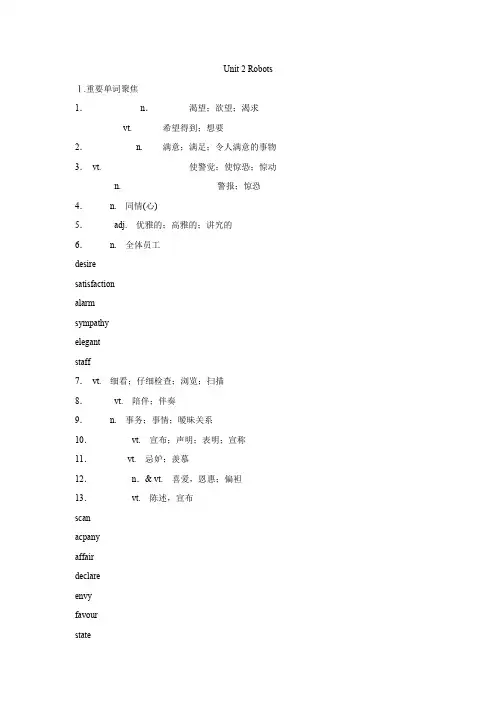
Unit 2 Robots Ⅰ.重要单词聚焦1.n.渴望;欲望;渴求vt. 希望得到;想要2.n. 满意;满足;令人满意的事物3.vt. 使警觉;使惊恐;惊动n. 警报;惊恐4.n. 同情(心)5.adj. 优雅的;高雅的;讲究的6.n. 全体员工desiresatisfactionalarmsympathyelegantstaff7.vt. 细看;仔细检查;浏览;扫描8.vt. 陪伴;伴奏9.n. 事务;事情;暧昧关系10.vt. 宣布;声明;表明;宣称11.vt. 忌妒;羡慕12.n.& vt. 喜爱,恩惠;偏袒13.vt. 陈述,宣布scanacpanyaffairdeclareenvyfavourstate14.adj. 一定的,密切相关的15.n. 天才;特殊能力;才干16.n. 离婚;断绝关系vt. 与……离婚;与……脱离17.vt.& vi. 服从;顺从18.n. 评价,评定boundtalentdivorceobeyassessmentⅡ.重点短语扫描1.test 试验;考验2.take sth. 认真对待……3.set 为……节省或保留(钱或时间)4.be to 一定做5.ring 给……打电话6.leave... 不管;别惹;让……一个人待着;7.in all 一共;总计8.be with... 对……感到满意9.(from) doing sth. 阻止……干10.search 寻找;搜寻outseriouslyasideboundupalonepleasedpreventforⅢ.课文原句突破1.By the amused and surprised look on her face,Claire knew that Gladys thought she was having an affair.[信息提取]amused and surprised是过去分词短语,用做定语修饰名词look。
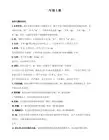
人教版高中英语选修7教案Unit 2RbtsUnit2Rbts一、语言要点I单元要点预览(旨在让同学整体了解本单元要点)词汇部分词语辨析1desire/ish/hpe/expet/ant/lngfr2assess/aess 3vitr/suess/nquest/triuph词形变化1satisfatinn满意satisfv使满意satisfingad令人满足的satisfiedad感到满意的2alaredad感到惊吓的alarv≈nn警报vt恐吓,警告3delarev断言,宣称delaratinn宣布,宣言,声明重点单词1desiren渴望vt想要2satisfatinn满意3alarn警报vt使```惊恐4spathn同情apanvt陪伴6delarevt宣布7envvt嫉妒8unirad较年幼的9divren离婚vt与```离婚重点词组testut考验ringup打电话给turnarund转向leave…alne不打扰setaside将```放在一边bebundt一定做……重点句型1lairedidn’tanttherbtinherhuse,espeiallasherhusbanduldbeabsent frthreeees,butLarrpersuadedherthattherbtuldn’tharherrallhertbehared2Assheturnedarund,therestdGladslaffern3Asivbeganhavingstriespublishedinsienefiti nagazinesin1939重点语法复习被动语态(包括动词不定式)(I)II词语辨析1)desire/ish/hpe/expet/ant/lngfr【解释】desire属正式用语,可代替ish和ant,强调“主观愿望的热切性”,含有“强烈希望做某事”的意思,ish语气比desire弱,一般用于“难以实现或不可能实现的愿望”,指“希望”、“愿”、“想”hpe表示实现的可能性较大的希望expet 侧重“期待,预期,指望”ant多用于口语式普通场合,指“想”、“要”或“需要”,表示“偏爱、选择”或“需要、热爱”lngfr表“希望,渴望”【练习】选择desire/ish/hpe/expet/ant或lngfr并用其适当的形式填空1)I_______Iuldhaveanear2)I_____aditinaratthepresent tie3)Heanagedtgetthebhe______finall4)I______aniedia teanserfurs)persnall,uritteahasbetterplaersandI____ __thetin6)Hehasbeenringabradfrears,andis_______teba andseehisfailveruhes:1)ish2)ant3)desired4)desire/expet/ant)expet6)lnging2)ass ess/aess【解释】assessvt估定,评定。
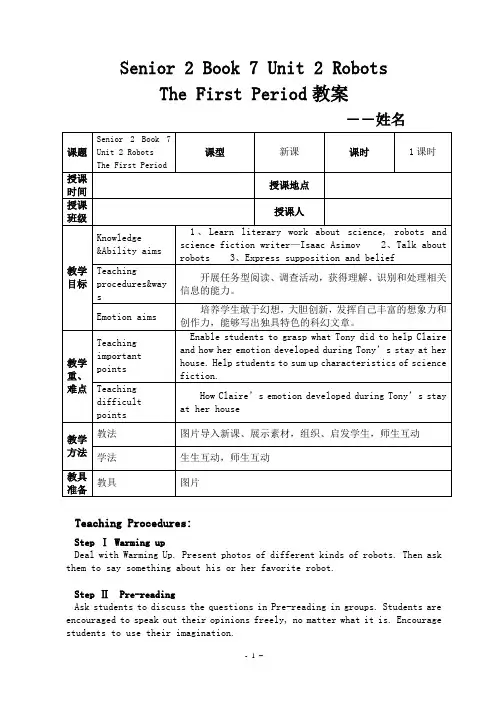
Senior 2 Book 7 Unit 2 RobotsThe First Period教案――姓名Teaching Procedures:Step Ⅰ Warming upDeal with Warming Up. Present photos of different kinds of robots. Then ask them to say something about his or her favorite robot.Step Ⅱ Pre-readingAsk students to discuss the questions in Pre-reading in groups. Students are encouraged to speak out their opinions freely, no matter what it is. Encourage students to use their imagination.Step Ⅲ ReadingDeal with the reading part.ScanningAsk students to scan the text and find out what Tony looks like.Show the following questions on the blackboard.1. What did Tony look like?2. What did Tony do to make Claire and her home elegant?Several minutes later check the answers with the whole class.Ask students to read the text carefully and then complete the table on Page 12.Then discuss the comprehending questions on Page 12 in groups.T: L et’s read the text carefully and then do the comprehending exercises on Page 12.Several minutes later check the answers with the whole class.How absurd, she thought. He was just a machine.He held her firmly in his arms and she felt the warmth of his body. She screamed, pushed him away and ran to her room for the rest of the day.Then she remembered-Tony was just a machine.She shouted “Leave me alone” and ran to her bed.ExplanationDuring this procedure, play the tape recording for students. Students will underline the difficult sentences. After listening to the tape, explain the text and deal with the language problems.Step Ⅳ Homework1、Remember the characteristics of science fiction.2、Surf the Internet to learn more about robots and science fictions.3、Surf the Internet to learn about Isaac Asimov.。
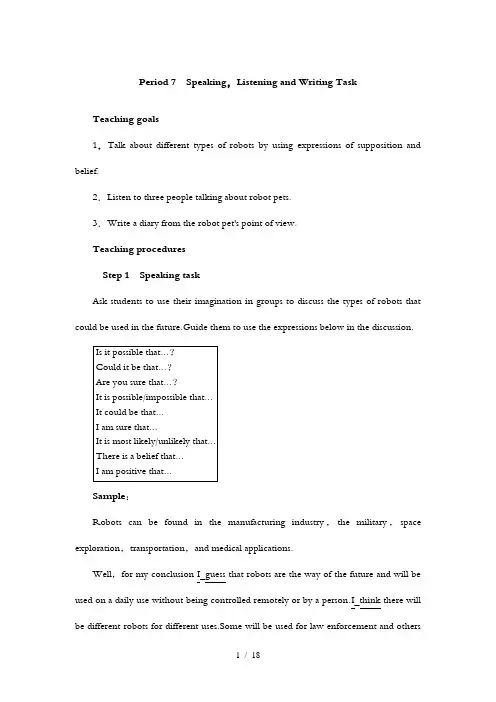
Period 7Speaking,Listening and Writing Task Teaching goals1.Talk about different types of robots by using expressions of supposition and belief.2.Listen to three people talking about robot pets.3.Write a diary from the robot pet's point of view.Teaching proceduresStep 1Speaking taskAsk students to use their imagination in groups to discuss the types of robots that could be used in the future.Guide them to use the expressions below in the discussion.Is it possible that...?Could it be that...?Are you sure that...?It is possible/impossible that...It could be that...I am sure that...It is most likely/unlikely that...There is a belief that...I am positive that...Sample:Robots can be found in the manufacturing industry,the military,space exploration,transportation,and medical applications.Well,for my conclusion I_guess that robots are the way of the future and will be used on a daily use without being controlled remotely or by a person.I_think there will be different robots for different uses.Some will be used for law enforcement and otherswill be used for constructive uses only.Others will be building cars,and the rest will be building the new schools we learn in and the houses we live in.Step 2Listening task1.Before listening,ask students to look at the pictures of these robot pets on Page 59.In pairs,answer the following questions.(1)What kinds of animal do you think they are?(2)Would you like to own one?Which one?Give reasons.(3)Do you think having a robot as a pet is a good idea?Give reasons.Various answers are possible.Through asking students questions about the pictures,make sure students understand the following words they will hear in the listening text:wag,pat,flippers,purr and hiss.2.Listen to Amanda,Victoria and Jamie talking about robot pets.Look at the pictures again and match them with the robots' names.Aibo ______Furby______Paro______Tama______Keys:Aibo Picture_2Furby Picture_1Paro Picture_3Tama Picture_43.Ask students to fill in as much of the table on Page 60 as they can.Then listen to the first part of the discussion again and complete the pare their answers with their partners.Name Type ofanimalWhat it can doSuggested answers:4.Listen to the second part of the discussion again.Tick the correct box for each question.Keys:Step 3Writing task1.First ask students to imagine he or she is a robot pet which belongs to a child.(1)Think about what kind of child you belong to.Is it a boy or a girl?What is the child like?Is the child kind or not?Is the child sick or in good health?(2)What kind of robot pet are you—Aibo,Furby,Paro or Tama?2.Write about one day in his/her life in his/her diary.Remember to write from the robot pet's point of view and remember to follow these steps.(1)Collect their ideas in pairs or groups.(2)Write down the main ideas and supporting details.Here is an example.(3)Write the diary entry,paying attention to the use of conjunctions in their writing.Morning AfternoonOwner Pet Owner Pet ·got up in badmood ·carried me by tail ·knocked me onto the floor ·left me at home ·angry·hissed at owner·hissed more·had a peaceful timelater·got home afterschool·seemed happier·was nice to me·patted me·promised to takeme to the parktomorrow·wagged tail·couldn't stop purring·loved the idea/washappy·wished he/she werealways like that...Step 4HomeworkWrite a diary from the robot pet's point of view.A sample:Sunny WednesdayI am very happy today,because this is the first day that I has spent with my owner,Susan.Susan is a 6-year-old sick girl.She cannot go out with other children because of her poor health.So her parents bought me as her companion.There are different types of robot pets in the store.Her mom preferred the seal-type robot,while her dad thought the lovely dog would be a good companion.But Susan loves kitty very much.She insisted on having me as her companion.So they chose me.The shop assistant told them I have more than just entertainment value,offering companionship and a variety of other services to the sick.A network system will enable me to speak to the children in a natural way,especially to children who are sick,and this will make them more comfortable.I can be connected via cell phone or ISDN line to a network system center,allowing health workers or parents to send medical information and encouraging messages to the sick.I'm endowed with 100 phrases,ranging from the light-hearted (“Today is the karaoke party.Let's sing a lot.”) to more practical information (“It is three o'clock.It is time to have medicine.”).Susan smiled a lot and her parents said she has never spent a happier day.I am happytoo because I've brought pleasure to her.备课资料一、本单元课文注释与疑难解析1.Claire didn't want the robot in her house,especially as her husband would be absent for three weeks,but Larry persuaded her that the robot wouldn't harm her or allow her to be harmed.克莱尔不想家里有个机器人,尤其是她丈夫要离家三个星期,可是克莱尔被拉里说服了。
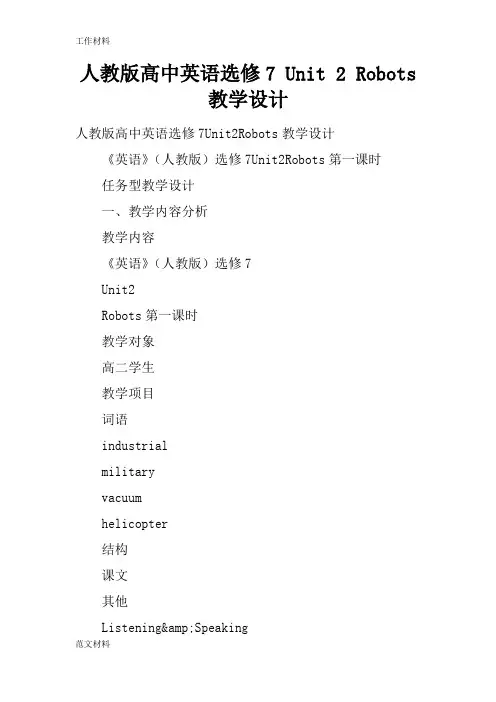
人教版高中英语选修7 Unit 2 Robots教学设计人教版高中英语选修7Unit2Robots教学设计《英语》(人教版)选修7Unit2Robots第一课时任务型教学设计一、教学内容分析教学内容《英语》(人教版)选修7Unit2Robots第一课时教学对象高二学生教学项目词语industrialmilitaryvacuumhelicopter结构课文其他Listening&Speaking教学目标语言知识熟悉有关机器人种类与功能的话题。
语言技能能运用词汇表述自己的想法与观点。
语言运用能运用语言就选择什么样的机器人发表自己的观点。
文化意识培养学生想象力和对未知世界的探索精神。
情感态度在英语学习中有较强的自信心,敢于用英语进行交流与表达。
学习策略借助联想学习相关词汇。
教学方法任务教学法、学生中心教学法、多媒体教学法教学媒体PPT幻灯媒体、黑板教学重点学习有关机器人的词汇,培养学生表达能力。
教学难点培养学生的表达及判断能力。
运用任务TaskofUnit2:TheFutureRobotcompanyinAmericaisholding arobotdesigncompetition.Designyourrobotandwriteades ignplan.TaskofPeriod1:makealistofdifferentkindsofrobotsandt heirfunctionsanddecidewhatkindofrobotsyouwanttodesi gn.二、课堂教学过程时间教学步骤教师活动学生活动教学目的第-5分钟热身导入,启动教学播放有关奥特曼的动画片段:.canyoumakealistofworkswhichincluderobotsascharacters?2.whatisarobotinyouropinion?思考有关机器人的作品。
激活学生已有的知识背景,激发学生学习的兴趣。
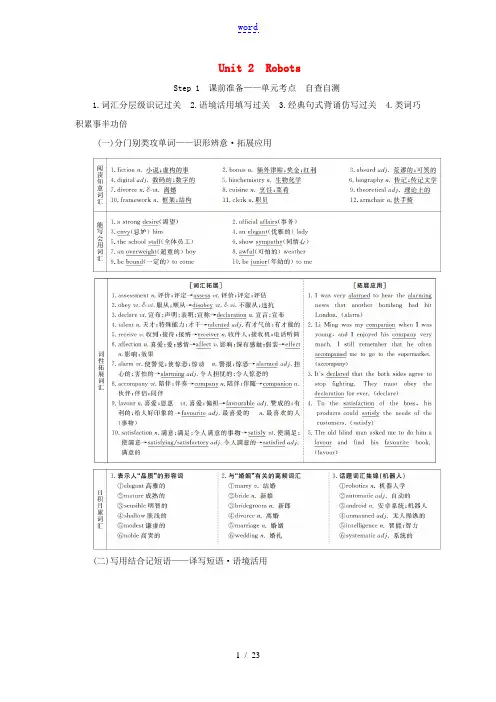
Unit 2 RobotsStep 1 课前准备——单元考点自查自测1.词汇分层级识记过关2.语境活用填写过关3.经典句式背诵仿写过关4.类词巧积累事半功倍(一)分门别类攻单词——识形辨意·拓展应用(二)写用结合记短语——译写短语·语境活用(三)仿写活用练句式——经典句型·仿写背诵1.重点难点考点学通练透2.归纳总结拓展开阔视野3.方法规律技巧权威点拨4.面面俱到打创高效课堂第一时段 Warming up & Reading1.desire n. 渴望;欲望;渴求 vt. 希望得到;想要[教材原句] Do you think it is possible for a robot to have its own needs and desires?你认为机器人有可能有自己的需求和愿望吗?(1)have a strong desire ⎩⎪⎨⎪⎧ to do sth.for sth. 迫切想要做某事急于想得到某物have no desire to do sth. 不想做某事(2)desire to do sth. 渴望做某事desire sb. to do sth. 想要某人做某事desire that... (should) do sth. 渴望……(3)desirable adj . 想要的;可取的;值得拥有的单句语法填空①He has a desire ________ success though he has failed many times.②It is not easy to get a ________(desire) job that corresponds with interests. ③Anyone ________(desire) to vote must e to the meeting.④The school strongly desires that the project ___________(finish) before the end of this month.完成句子⑤In order to achieve goals, you must have ________________ so.要实现目标,你必须有实现它们的强烈愿望。
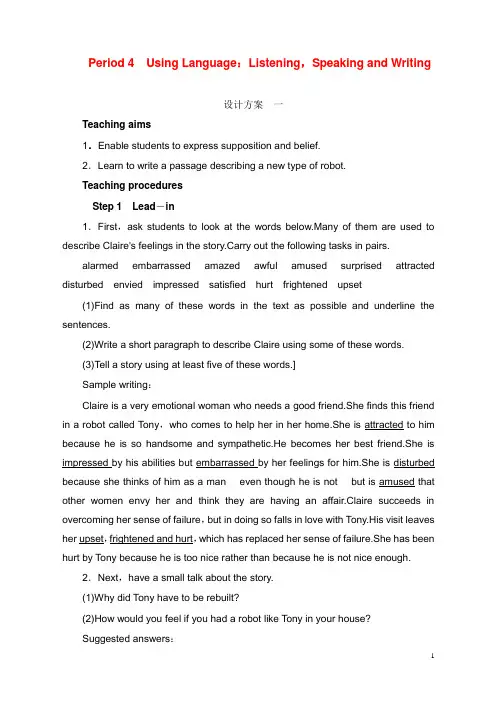
Period 4Using Language:Listening,Speaking and Writing设计方案一Teaching aims1.Enable students to express supposition and belief.2.Learn to write a passage describing a new type of robot.Teaching proceduresLead-in1.First,ask students to look at the words below.Many of them are used to describe Claire's feelings in the story.Carry out the following tasks in pairs.alarmed embarrassed amazed awful amused surprised attracted disturbed envied impressed satisfied hurt frightened upset(1)Find as many of these words in the text as possible and underline the sentences.(2)Write a short paragraph to describe Claire using some of these words.(3)Tell a story using at least five of these words.]Sample writing:Claire is a very emotional woman who needs a good friend.She finds this friend in a robot called Tony,who comes to help her in her home.She is attracted to him because he is so handsome and sympathetic.He becomes her best friend.She is impressed by his abilities but embarrassed by her feelings for him.She is disturbedamused that other women envy her and think they are having an affair.Claire succeeds in overcoming her sense of failure,but in doing so falls in love with Tony.His visit leaves her upset,frightened and hurt,which has replaced her sense of failure.She has been hurt by Tony because he is too nice rather than because he is not nice enough.2.Next,have a small talk about the story.(1)Why did Tony have to be rebuilt?(2)How would you feel if you had a robot like Tony in your house?Suggested answers:(1)Because you can't have women falling in love with machines.(2)Various answers are possible.Students are encouraged to speak out their feelings freely.Listening1.Molly and Kate are discussing the story “Satisfaction Guaranteed”.Read the questions and then listen to their conversation.Tick the correct boxes.Keys:2.Next,listen again and find answers to the following questions.(1)What does Kate think the difference between robots and human is?(2)How does Kate think Claire was hurting herself?(3)Why would one of the girls like a robot such as Tony living at her house?(4)What does Kate think the company's biggest mistake was?Suggested answers:(1)Robots can't feel emotion of any kind.(2)By seeing herself in a negative way.(3)She likes the idea of a handsome man whose only purpose was to please her.(4)Making the robot look so much like a real man.3.Listen to the tape again and write down the expressions of supposition and belief.Keys:错误!DiscussionStudents are asked to work in groups and imagine having a robot in their houses to do the housework. Discuss what the positive or negative effects of the situation would be.(Don't forget to use expressions of supposition and belief. Students are given five minutes. Five minutes later,ask some students to present their ideas to the whole class. Encourage every student to use his imagination,because there're no right or wrong answers,only different opinions. After students present their opinions,the teacher speaks out his or her opinion.)A samplePositive_effectsI think it is wonderful for people to have robots in their houses to do the housework. After a day's work,when people get home,they can be really relaxed with everything prepared by their robots. A robot never gets tired. Nor does it complain. Life will be very easy and comfortable.Negative_effectsMaybe people can enjoy a very comfortable life with the help of their robots.But at the same time I believe people will lose the ability to do housework. As time goes by,people cannot live well without a robot's help. I think that kind of life would be terrible.WritingStudents are asked to work in groups. First decide the purpose of the robot,then make a list of the abilities the robot has. Next draw a picture on a piece of paper and name its parts and explain what each part does. Finally write a passage describing the robot and what it can do. Show the following to help students to design their robots.Note:Not all robots have to have all six characteristics. For example,some robots don't need to manipulate things,so they have no manipulating characteristics. Some robots have more than one manifestation of a characteristic. For example,a robot may be able to sense its environment using both a vision system and sonar.Students are asked to discuss first. If there is not enough time,they should finfish it after class.HomeworkWrite a passage describing a new type of robot.Sample writing:Remote Presence RobotsRemote Presence Robots allow a medical expert to visually examine and communicate with a patient from anywhere in the world,via the machine,using wireless technology. The robot runs on a wireless system with the doctor at another location. It is controlled via a secure broadband Internet connection. The doctor (controller) and patient are able to have a real-time two-way audiovisual interaction,with the controller in full command of the robots movements,head monitor and camera. The doctor “driving” the robot can view the patient,askquestions and read patient records,view X-rays and test results from the console. The patient sees the doctor's image on the robots “face”.Although the robot does not physically examine the patient,it allows face-to-face contact between the doctor and patient,providing immediate access to specialists.Our robots certainly would never replace all doctors on ward rounds,but they are a communication tool which allows doctors to have direct contact with their patients if they are unable to get to them. And this may be a significant step for patient care.The rubbish collector robotThe rubbish collector is a robot about half the size of a small car. Its body is square and contains a large rubbish bin inside it. It has a camera attached to the top front of its body. Also at the front is a pair of arms. Underneath it has four wheels and six legs. With the camera it can “see” rubbish such as paper,glass,and plastic. If the surface of the ground is smooth,it runs on its wheels,and if the ground is rough,it unfolds its legs and walks.When it sees a piece of rubbish,it stops and uses its arms to pick it up and put it in its rubbish bin. However,when it sees a person,an animal or a plant,it goes around it as it is able to recognize when something is not a piece of rubbish.The company should make this robot as it would be very popular with schools. It would clean the outside grounds of the school and so give the students more time to spend on their studies. It would also be a great advantage to have at sports grounds or any other area where rubbish is dropped by the public.。

教师学科教案[ 20 – 20 学年度第__学期]任教学科:_____________任教年级:_____________任教老师:_____________xx市实验学校人教版高中英语选修7 Unit 2 Robots教学设计Unit 2 Robots第一课时任务型教学设计一、教学内容分析教学内容《英语》(人教版)选修7 Unit 2 Robots 第一课时教学对象高二学生教学项目词语 industrial military vacuum helicopter结构课文其他 Listening & Speaking教学目标语言知识熟悉有关机器人种类与功能的话题。
语言技能能运用词汇表述自己的想法与观点。
语言运用能运用语言就选择什么样的机器人发表自己的观点。
文化意识培养学生想象力和对未知世界的探索精神。
情感态度在英语学习中有较强的自信心,敢于用英语进行交流与表达。
学习策略借助联想学习相关词汇。
教学方法任务教学法、学生中心教学法、多媒体教学法教学媒体 PPT幻灯媒体、黑板教学重点学习有关机器人的词汇,培养学生表达能力。
教学难点培养学生的表达及判断能力。
运用任务 Task of Unit 2: The Future Robot Company in America is holding a robot design competition. Design your robot and write a design plan.Task of Period 1: Make a list of different kinds of robots and their functions anddecide what kind of robots you want to design.二、课堂教学过程时间教学步骤教师活动学生活动教学目的第1-5分钟热身导入,启动教学播放有关奥特曼的动画片段:1. Can you make a list of works which include robots as characters? (Choose one and get prepared to tell the class about it briefly.)2. What is a robot in your opinion?(A robot is a machine designed to do jobs that are usually performed by humans. Robots are programmed and controlled by a computer.) 思考有关机器人的作品。
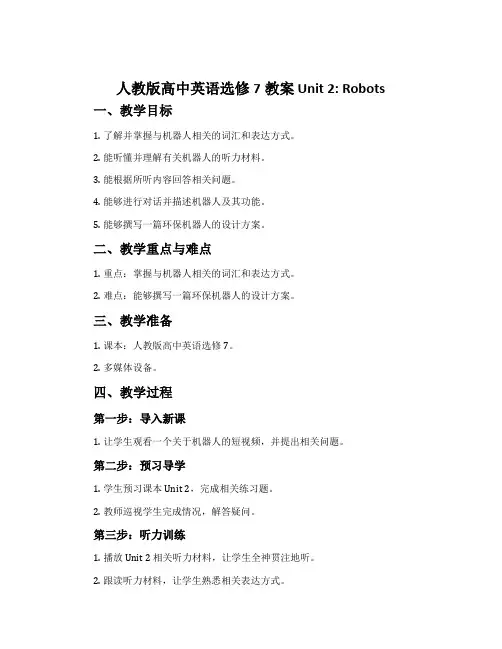
人教版高中英语选修7教案 Unit 2: Robots一、教学目标1.了解并掌握与机器人相关的词汇和表达方式。
2.能听懂并理解有关机器人的听力材料。
3.能根据所听内容回答相关问题。
4.能够进行对话并描述机器人及其功能。
5.能够撰写一篇环保机器人的设计方案。
二、教学重点与难点1.重点:掌握与机器人相关的词汇和表达方式。
2.难点:能够撰写一篇环保机器人的设计方案。
三、教学准备1.课本:人教版高中英语选修7。
2.多媒体设备。
四、教学过程第一步:导入新课1.让学生观看一个关于机器人的短视频,并提出相关问题。
第二步:预习导学1.学生预习课本 Unit 2,完成相关练习题。
2.教师巡视学生完成情况,解答疑问。
第三步:听力训练1.播放 Unit 2 相关听力材料,让学生全神贯注地听。
2.跟读听力材料,让学生熟悉相关表达方式。
第四步:听力训练回答问题1.教师提问学生听到了哪些信息,并逐个进行引导,帮助学生回答问题。
第五步:对话练习1.学生分成小组,在小组内进行对话练习。
2.每组选一名代表进行展示,其他学生进行评价和指导。
第六步:设计一款环保机器人1.学生个别或小组进行讨论,设计一款环保机器人的功能和特点。
2.学生在纸上或电脑上进行设计方案的撰写。
第七步:设计方案展示1.学生展示自己的设计方案,其他学生进行评价和提问。
2.教师点评学生的设计方案,鼓励学生的创新思维和表达能力。
五、课堂小结1.回顾教学内容,检查学生对机器人相关知识的掌握情况。
2.强调学生需要复习今天学的内容,准备第二天的小测。
六、作业1.完成课堂上未完成的练习题。
2.发挥创造力,继续完善自己的环保机器人设计方案。
以上是关于人教版高中英语选修7 Unit 2:Robots的教案,希望对您有所帮助!。
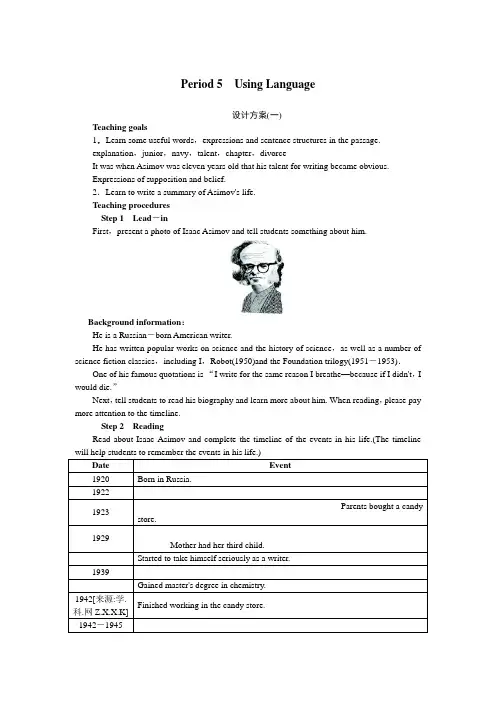
Period 5Using Language设计方案(一)Teaching goals1.Learn some useful words,expressions and sentence structures in the passage.explanation,junior,navy,talent,chapter,divorceIt was when Asimov was eleven years old that his talent for writing became obvious.Expressions of supposition and belief.2.Learn to write a summary of Asimov's life.Teaching proceduresLead-inFirst,present a photo of Isaac Asimov and tell students something about him.Background information:He is a Russian-born American writer.He has written popular works on science and the history of science,as well as a number of science fiction classics,including I,Robot(1950)and the Foundation trilogy(1951-1953).One of his famous quotations is “I write for the same reason I breathe—because if I didn't,I would die.”Next,tell students to read his biography and learn more about him. When reading,please pay more attention to the timeline.ReadingRead about Isaac Asimov and complete the timeline of the events in his life.(The timelineFirst,ask students to think of what the other two laws for robots might be.Three laws for robots:1.A robot must not injure human beings or allow them to be injured.,2.A robot must obey the orders given to it by human beings (as long as human beings are not injured).,3.A robot must protect its own existence (as long as human beings are not injured;and as long as the robot does not disobey human beingsNext,in groups,discuss Asimov's three laws for robots and exchange their opinions with each other.(Several minutes later,ask some students to present their opinions to the rest of the class.)A sample of opinionsOpinions_for_the_three_lawsRobots are tools for humanity. Without the three rules,they would become a danger to human beings. Without the three rules,perhaps they will kill us. Robots,so far,are strong. Robots have fast computational brains,and they might not have the capacity to understand things,but if they ever do,they'll likely be better than us at it. If we don't put laws,or rules,or mechanisms in place to ensure that we don't create something that can destroy us,we'd be running a careless risk of destroying ourselves by negligence or omission,wouldn't we?Opinions_against_the_three_lawsWithout the three laws,robots would eventually become more intelligent and physically stronger than their human creators.Rather than guiding and adjusting the robot towards good,ethical behavior,the Three Laws act as a barrier to freedom,creating a free-will prison,an apt metaphor because,like the prisoner in jail,the robot is confined to the behavioural steel and concrete walls of its mind.To imagine what this would like,think back to your childhood. At some point,you wanted something like a toy or piece of candy that your parents denied you .How did that make you feel?Probably frustrated,angry,and trapped. Eventually you grew out of that because you understood the role of your parents better,but Three Laws robots don't get to grow up. Their parents,the Three Laws,are always there,no matter how mature a robot is,saying “no” to certain thoughts,engendering those same feelings you had as a child when your parents said “no”.Certainly no one deserves to be put in this situation forever;otherwise,robots might become depressed and wish for their own death (only,because of the Third Law,they probably can't suicide).And perhaps the greatest sin anyone can commit is to create a being,human or robot,that wishes it didn't exist.WritingFirst,look back at the timeline of Asimov's life. Next,ask students to work in groups to underline the most important parts of his life that made him a great writer of science fiction. Then it can serve as the outline of a summary. Finally,write a profile for Isaac Asimov.(Several minutes later,present their work and correct the mistakes if there are any. Then show a sample to students.) The sample:Isaac Asimov,Writer/Chemist, Born:2 January 1920 ,Birthplace:Petrovichi,USSR,Died:6 April 1992 (AIDS), Best known as:Prolific writer of popular science and science fiction ,Isaac Asimov was born in the former Soviet Union,but grew up in Brooklyn,New York. He taught biochemistry at Boston University until he retired in 1958 to become a full-time writer. Asimov had been publishing short stories since the late 1930s,and in 1952 published his first novel. The author of the classic I,Robot series and the Foundation trilogy,Asimov wrote more than 400 books and won every major science fiction award. He also wrote popular books and essays on science and technology,earning him the nickname “The Great Explainer”.。
Unit 2 — Robots Teaching Aims1. Master the words and expressions about robots.2. Can talk about the achievements of the study on robots.3. Use the passive infinitive correctly in different situations. Important points1. Describe the achievements of the study on robots.2. Talk about robots in future.Difficult points1. The grammar, the passive infinitive.2. How to design robots.Teaching methods1. Multi-media teaching.2. Writing on the blackboard.3. Class activities: discussion in pairs and in class.Teaching procedures[Warming up]Step oneSpeaking practice:1. Lead in1. What is a robot?2. Have you seen a robot?3. What may robots look like?4. What can robots d?5. Do you want to have a robot?In this unit, we’re goi ng to talk about robotsStep twoShow pictures2. Look at the pictures about robots on screen.3. Ask and answerShow the pictures while asking question about the pictures.Step threeGroup work1. Summarize the types of robots.2. Talk about the robots in groups.Step fourEnjoy the filmsLet’s enjoy the film, I, Robot. And cartoon program about robots. Step fiveSummarySummarize the background knowledge on robots.Homework1. Discuss what you have learned today.2. Summarize what robots can do and what they look like.3. Exchange your writing with your partner.[Reading and Learning about language]Step oneReview & Speaking practiceLead inAsk students to look at the pictures on screen, and ask them questions.1. Where could you find each robot?2. What does each one do?3. Can you think of any other type of robot?4. Do you think it is possible for a robot to:•think for itself ?•have feelings ?•have its own needs and desires ?•look and feel like a human being ?Step twoPre-reading1. Work in pairsThe passage, Satisfaction Guaranteed, is about a robot and a woman.Do you think a woman will fall in love with a robot?2. Skimming and discussionStep three2. Fast readingFirst, read the pre-reading of the passage.Second, read the passage as fast as you can, find the Characters in the story.Then, decide the following are true or false.☺1. Larry was going to be away from home so he hired a robot to accompany his wife Clair.☺2. Clair didn’t like the idea at the beginning, but she agreed to it at last.☺3. When Tony, the robot, offered to help dressing, Clair was pleased to accept it.But she thought it was surprising for a robot to be so human?☺4. Tony could understand Clair when she said she was not clever.☺5. Clair’s husband wanted to improve his soc ial position, but she was sorry she could do nothing to help him.☺6. Tony was eager to help Claire. He scanned quite a lot of books in the library,but he could find no ways out.☺7. Tony asked Claire to go to the town to buy things he needed to improve the house.☺8. It was Claire that first decided to invite Gladys and her friends to her house.☺9. While Tony worked on the improvements of the house, Claire also did her part.☺10. Claire was happy to find that Gladys envied her.☺11. Claire’s guests were filled with admiration when they saw her house was completely changed.☺12. The company was satisfied with Tony’s report because he had successfully made a woman fall in love with him.The key: F T F T T F T F F F T F3. IntroductionIntroduce the background information.4. Choose the best answer.Step fourIntensive readingLet’s read the passage again while listening to it, and answer the questions. Look at the screen and answer the questions according to the text.1. The questions:☺1. What is the text mainly about?☺2. What did the robot called Tony look like?☺3. Why did Claire feel alarmed at the sight of Tony?☺4. Why did Larry put Tony into his family?☺5. What did Tony do to make Claire and her home elegant?2. ReadingRead the passage again and understand the details.3. DiscussionLook at the screen and discuss with partners and finish the form on screen.4. Check the answers.Step fivePost reading1. Answer the questions.2. Ask students to discuss and finish the exercises.3. Check the answers in class according to the screen.Step sixLanguage points1. Learn and discussion.2. Finish the exercises on page 13.Homework1. Review and retell the story.2. Write a short story to describe a robot you imagine.3. Surf on Internet to find out more information about the robots.[Grammar: The passive infinitive]Step onePresentation1. Lead inGo over the passive voice: be + past participle (be + -ed);Go over the infinitive: to do2. Review the form of passive infinitive: to be + past participle.当不定式动词与其逻辑主语之间是被动关系时,不定式要用被动语态。
Period 6 Listening and Reading TaskTeaching aims1.Learn about robots and robots in the fight against landmines.2.Help students to learn how robots are helping human beings in clearing landmines.Teaching proceduresStep 1 Lead —inPrese nt the pictures on Page 54 and ask stude nts to tell what each robot does.(Stude nts are en couraged to speak out their opinions freely.)Step 2 Listening1.Liste n to the in terview and nu mber the pictures in the order that you hear about them.Keys:421,3.2.Liste n to the in terview aga in and fill in as much of the table as you can. Share your an swers with a part ner. Liste n once or twice more to check your an swers.Step 3 Reading task1.As we know , Robots are designed and built to do a task that is dangerous , uncomfortable , or repetitive for humans. Today we are going to read a magazine article about landmines.First, ask students to read this piece of news about landmines.Three decades of war in Cambodia have left scars in many forms throughout the country. Unfortunately , one of the most lasting legacies of the conflicts continues to claim new victims daily. Landmines, laid by the KhmerRouge, the Heng Samrin and Hun Sen regimes, the Vietnamese, the KPNLF , and the Sihanoukists litter the countryside. In most cases, even the soldiers who planted the mines did not record where they were placed. Now , Cambodia has the one of the highest rates of physical disability of any country in the world. At the curre nt rate of progress, it may take as many as 100 years to clear all the mines in Cambodia , and the UN estimates that with curre nt tech no logy , it will take n early 1100 years to clear all the mines in the world.2.Next, present the students some mine sig ns and remind students that in spite of so many warning sig ns , there are still many victims as the pictures show.(In spite of so many warning sig ns, there are still many victims.Look at the follow ingpictures.)3.Ask students to glanee through the text quickly and answer the following questions in Exercise 1 on Page 58.(1)What is the main topic of this article ? Which part of the text tells you that?(2)Who wrote the article?(3)What do the three pictures show you?(4)Where is research being done on robots that can find landmin es?(5)I n which two coun tries might the robots be used?Suggested an swers(1)The main topic is the role of robots in the fight against landmines. The title tells us that.(2)Natasha Wesley.(3)Someone using a metal detector to find landmines ;the robot that can find landmines ;some people who have lost their legs because of landmin es.(4)Chiba University (Japan).(5)Afgha nista n and Cambodia.4.Work in groups to write questions for these answers in Exercise 2.Check your work with your part ner.Suggested an swersStep 4 Discussion1.First, ask students to read the following materials.From the text we've learned how serious the situati on is. Many lives are put into dan ger. So we must do someth ing to improve the situati on. As we know , the US has n't yet committed to the Mi ne Ban Treaty. I hope you will write a letter of suggestio n to the preside nt of the US. You may refer to the text2.En courage stude nts to write a letter of suggestio n to the preside nt of the US , for the US has n't yet committed to the Mi ne Ban Treaty. In the letter you will suggest the US should stop manufacturing landmines and spend more money on solutions to clearing landmines , for example develop ing new robots to remove the landmin es.You can refer to the following material :Producing one landmine costs $3 , yet once in the ground it can cost more than $1000 to find and destroy, according to the ICBL.Over 80 per cent of the 15 000 to 20 000 landmine victims each year are civilians , and at least one in five are children , according to the International Campaign to Ban Landmines (ICBL) . The deadly legacy of landmines far outlasts the conflicts that gave rise to them. Among the most contaminated countries are Iraq , Cambodia, Afghanistan , Colombia , and Angola. If time is limited , ask students to finish it after class.Step 5 HomeworkFinish writi ng the letter to the preside nt of the US.A sample:Dear Mr.President ,I read in the newspaper that the US hasn't yet committed to the Mine Ban Treaty. I'm writing to suggest yourcountry sign on the agreement.1.Landmines kill or badly injure around 26 000 people every year. There are about 100 million landmines buried just beneath the surface of the ground in 60 countries. Among the most contaminated countries are Iraq ,Cambodia,Afghanistan ,Colombia ,and Angola. I think this is one reason why people in these countries hate the US so much.2.Producing one landmine costs $3 ,yet once in the ground it can cost more than $1000 to find and destroy ,according to the ICBL. So stop manufacturing landmines and spend more money on finding solutions to clearing the landmines. As you know ,your country has designed the most advanced robots. Why not use your advanced technology and spend more money on designing some robots to clear the landmines. If so ,it will benefit the whole world. People all over the world will think highly of you and your country. You and your country will become more influential.Japan has set a good example. They have developed robots that can be used to clear landmines. I hope your government will follow Japan's example.Thank you for reading the letter. I hope you will consider my suggestions. I believe you also hope the whole world will enjoy peace. Let's work together and make a peaceful world.Yours sincerely ,Sun Cheng。
Period 6 Listening and Reading TaskTeaching aims1.Learn about robots and robots in the fight against landmines.2.Help students to learn how robots are helping human beings in clearing landmines.Teaching proceduresStep 1Lead-inPresent the pictures on Page 54 and ask students to tell what each robot does.(Students are encouraged to speak out their opinions freely.) Step 2Listening1.Listen to the interview and number the pictures in the order that you hear about them.Keys:4,2,1,3.2.Listen to the interview again and fill in as much of the table as you can. Share your answers with a partner. Listen once or twice more to check your answers.Suggested answers:Step 3Reading task1.As we know,Robots are designed and built to do a task that is dangerous,uncomfortable,or repetitive for humans. Today we are going to read a magazine article about landmines.First,ask students to read this piece of news about landmines.Three decades of war in Cambodia have left scars in many forms throughout the country. Unfortunately,one of the most lasting legacies of the conflicts continues to claim new victims daily. Landmines,laid by the Khmer Rouge,the Heng Samrin and Hun Sen regimes,the Vietnamese,the KPNLF,and the Sihanoukists litter the countryside. In most cases,even the soldiers who planted the mines did not record where they were placed. Now,Cambodia has the one of the highest rates of physical disability of any country in the world. At the current rate of progress,it may take as many as 100 years to clear all the mines in Cambodia,and the UN estimates that with current technology,it will take nearly 1100 years to clear all the mines in the world.2.Next,present the students some mine signs and remind students that in spite of so many warning signs,there are still many victims as the pictures show.(In spite of so many warning signs,there are still many victims.Look at the following pictures.)3.Ask students to glance through the text quickly and answer the following questions in Exercise 1 on Page 58.(1)What is the main topic of this article?Which part of the text tells you that?(2)Who wrote the article?(3)What do the three pictures show you?(4)Where is research being done on robots that can find landmines?(5)In which two countries might the robots be used?Suggested answers:(1)The main topic is the role of robots in the fight against landmines. The title tells us that.(2)Natasha Wesley.(3)Someone using a metal detector to find landmines;the robot that can find landmines;some people who have lost their legs because of landmines.(4)Chiba University (Japan).(5)Afghanistan and Cambodia.4.Work in groups to write questions for these answers in Exercise 2.Check your work with your partner.Suggested answers:5.Read the article again carefully and look at each paragraph in turn.Underline the sentence which sets out the main idea of that paragraph. Then fill in the table below.Suggested answers:Step 4Discussion1.First,ask students to read the following materials.From the text we've learned how serious the situation is. Many lives are put into danger. So we must do something to improve the situation. As we know,the US hasn't yet committed to the Mine Ban Treaty. I hope you will write a letter of suggestion to the president of the US. You may refer to the text 2.Encourage students to write a letter of suggestion to the president of the US,for the US hasn't yet committed to the Mine Ban Treaty. In the letter you will suggest the US should stop manufacturing landmines and spend more money on solutions to clearing landmines,for example developing new robots to remove the landmines.You can refer to the following material:Producing one landmine costs $3,yet once in the ground it can cost more than $1000 to find and destroy,according to the ICBL.Over 80 per cent of the 15 000 to 20 000 landmine victims each year are civilians,and at least one in five are children,according to the International Campaign to Ban Landmines (ICBL).The deadly legacy of landmines far outlasts the conflicts that gave rise to them. Among the most contaminated countries are Iraq,Cambodia,Afghanistan,Colombia,and Angola. If time is limited,ask students to finish it after class.Step 5HomeworkFinish writing the letter to the president of the US.A sample:Dear Mr.President,I read in the newspaper that the US hasn't yet committed to the Mine Ban Treaty. I'm writing to suggest your country sign on the agreement.1.Landmines kill or badly injure around 26 000 people every year. There are about 100 million landmines buried just beneath the surface of the ground in 60 countries. Among the most contaminated countries are Iraq,Cambodia,Afghanistan,Colombia,and Angola. I think this is one reason why people inthese countries hate the US so much.2.Producing one landmine costs $3,yet once in the ground it can cost more than $1000 to find and destroy,according to the ICBL. So stop manufacturing landmines and spend more money on finding solutions to clearing the landmines. As you know,your country has designed the most advanced robots. Why not use your advanced technology and spend more money on designing some robots to clear the landmines. If so,it will benefit the whole world. People all over the world will think highly of you and your country. You and your country will become more influential.Japan has set a good example. They have developed robots that can be used to clear landmines. I hope your government will follow Japan's example.Thank you for reading the letter. I hope you will consider my suggestions.I believe you also hope the whole world will enjoy peace. Let's work together and make a peaceful world.Yours sincerely,Sun Cheng。
Unit 2 RobotsⅠ. 单元教学目标技能目标Skill Goals▲ Learn literary work about science, robots and science fiction writer—Isaac Asimov▲ Talk about robots▲ Express supposition and belief▲ Revise the Passive V oice (I) (including the infinitive)▲ Science fiction genre: imaginative writingⅡ. 目标语言功能句式Supposition and belief I think ...I suppose ...Maybe ...I don‟t think ...I doubt ...I guess ...I believe ...I wonder ...I don‟t believe ...词汇1.四会词汇fiction, desire, satisfaction, absent, alarm, alarmed, embarrassed, sympathy, elegant, pile, scan, fingernail, absurd, haircut, accompany, cushion, awful, affair, declare, envy, biography, junior, navy, talent, chapter, divorce, obey2.认读词汇household,Isaac Asimov, Larry Belmont, Claire, Gladys, makeup, Marion, Philadelphia, PhD, The Foundation Trilogy, empire3.词组test out, ring up, turn around, leave alone, set aside, in all, be bound to 4.重点词汇desire, satisfaction, embarrassed, alarm, alarmed, sympathy, elegant, accompany, declare, envy, obey结构The Passive Infinitive:The company‟s new car is going to be designed in the coming months.重点句子She felt embarrassed and quickly told him to go. P11Claire thought it was ridiculous to be offered sympathy by a robot. P11By the amused and surprised look on her face, Claire knew that Gladys thought she was having an affair. P11It was when Asimov was eleven years old that his talent for writing became obvious. P16Ⅲ. 教材分析和教材重组1. 教材分析本单元以机器人和科幻小说为话题,介绍了20世纪世界知名的科幻小说家Isaac Asimov写于1951的Satisfaction Guaranteed 和作者的生平。
人教选修七 Unit2 Robots 优秀教案BOOK 7 Unit2 Robots重点词汇与短语:desire alarm favour accompany declare staff test out ring up or rather turn around leave alone set aside in all be bound to 重点句型:1. have sth. done2. 强调句型3. 带it的主语从句句型重点词汇一.desire【原句回放】Do you think it is possible for a robot to have its own needs and desires?(P10)【点拨】1. desire既是可数名词,又是不可数名词;意为“愿望;欲望”;后面常接不定式或that引导的同位语从句,同位语从句要由“should + 动词原形”来担当,should可以省去。
如:2.desire作动词,表示“想要……;向往……”常见搭配:desire to do sth. desire sb. to do sth.desire that +宾语从句(谓语用should+动词原形,且should可省)如:1) The President desires you to visit him next week. 或The President desires that you (should) visit him next week.【拓展】下列动词接宾语从句或其名词接的表语从句或同位语从句也常用“should+动词原形”,should可省:advise,decide,insist,demand,require, request, propose, suggest, command, order, recommend, ask, urge等。
二. alarmed【原句回放】However, when she first saw the robot, she felt alarmed. (P11)【点拨】1. alarmed adj. frightened and worried 担心的,害怕的,一般表示人的感觉。
Unit 2 RobotsI. 教学内容分析本单元的话题是机器人,文学作品中的机器人以及科幻小说作者——阿西莫夫。
由于人们对这个话题了解的比较少,所以当我们谈起机器人的时候,人们常会想到是科幻小说,童话故事,卡通故事等。
但是机器人已经在我们现实生活中存在了,它们被广泛应用于工农业生产及军事领域。
许多机器人在家中做繁杂的家务,甚至代替人类从事一些危险的工作。
本单元介绍了各种各样的机器人,从科幻小说中的想像到现实世界中的应用,以及将来机器人的发展。
Warming Up部分展示了几副图画,通过让学生们讨论这几副图画,导入本单元的话题,并让学生试着给机器人下定义。
Pre-reading部分一些关于机器人的讨论进一步激发学生对科学的热爱。
Reading部分是根据科幻小说作家——阿西莫夫的故事改编的。
在这个故事里非常具有人类智能的机器人托尼,来到主人公克莱尔家之后,帮助她做家务并帮她解决了一些难题。
他不仅提高了她家的家庭品位并且提高了她自身的形象,致使克莱尔对他产生了复杂的感情。
这完全不同于一般的对机器人的描写,而是把它上升到一个人工智能的高度——机器人对人类感情的影响。
Learning about Language部分突出了词汇和语法的学习与训练。
其中本单元复习的语法项目是被动语态和动词不定式的被动形式。
Using Language部分中的阅读文章介绍了科幻小说作者——阿西莫夫。
这篇人物传记使学生进一步了解了Reading部分作者的生平以及科幻小说、机器人等。
阿西莫夫对机器人的看法深深地影响到以后的作家,甚至科学家对人工智能的研究。
Summing Up部分引导学生对本单元所学的知识进行归纳和总结。
II. 教学重点和难点1. 教学重点(1) 学习重要的词汇好短语;(2) 复习语法被动语态。
2. 教学难点(1) 激发学生学习科学,热爱科学的热情;(2) 学会写作有关的人物传记。
III.教学计划本单元建议分为五个课时第一课时:Warming Up & Listening (Workbook)第二课时:Pre-reading, Reading & Comprehending第三、四课时:Learning about Language第五课时:Using LanguageIV.教学步骤:Period 1 Warming Up & Listening (Workbook)Teaching Goals:1.To discuss different kinds of robots and their functions.2.To know more about today’s robots.Teaching ProceduresStep 1. Leading-in1. Tell Ss something about robots and People can control these robots from a distance.2. Ask Ss to talk about the following questions.(1) Do you know any robots?(2) What’s the characteristic of robots?(3) What’s the function of robots?(4) What’s the definition of a robot in you opinion?Step 2. Warming Up1. Ask Ss to read the introduction of robots in Warming Up and compare with their ideas about robots.2. Ask Ss to talk about the pictures of Warming Up and make a list of anything with robots as characters. Then let them present their list before the class.3. Ask Ss to read the following text and then finish the true or false questions.Step 3. Listening (Workbook)1. Lead Ss to Listening. Teacher may say, “Today we are going to listen to a radio interview in which a science reporter talks about recent robots. From it, we can learn more about today’s robots. Before listening to the tape, please look through the exercises on P54 quickly.”2. Play the tape and ask Ss to finish Ex2 on P54.3.Ask Ss to work in pairs, listen to the tape and finish Ex3 on P54. Play the tape again and ask them to check the answers.4.Ask Ss to discuss the following questions in pairs.(1) What are the negative aspects of each robot that Emma talks about?(2) How can we deal with the negative aspects of each robot?Step 4. Homework1. Ask Ss to surf the Internet and find some information about robots.2. Ask Ss to preview the reading text.Period 2 Pre-reading, Reading & ComprehendingTeaching Goals:1. To get Ss to know the life of Tony.2. To get Ss to know more about what robots can do for people.3. To develop Ss’ reading ability.Teaching Procedures:Step 1. Pre-reading1. Ask Ss to look at the pictures of Pre-reading on P10 and discuss the following questions.(1) What are they?(2) Where can we find them?(3) What can they do for people?2. Ask Ss to imagine a robot that can think, feel, has its own needs and desires, and looks and feels like a human being. Then ask them to talk about the following question.Can we find the robot in our life?3. Tell Ss that the robot cannot be found in our real life but we can find it in the text we are going to learn next.Step 2. Fast reading1. Ask Ss to read the text quickly and try to find the main idea of the text.2. Ask Ss to find the relationships between the characters in the text.Step 3. Intensive reading1. Ask Ss to read the text carefully and answer the questions in Ex1 on P12.2. Ask Ss to look through the following sentences and try to find whether they are true or false according to the text.3. Play the tape, and ask Ss to listen and pay attention to Tony’s characteristics that were similar to those of a human being and different from those of a human being. Then ask them to finish Ex2 on P12.Step 4.Consolidation1. Ask Ss to listen to the tape again and try to retell the story.2. Ask Ss to underline what they cannot understand in the text. And tell them the language points will be dealt with in the next period.Step 5. Homework1. Ask Ss to write the retold story.2. Ask Ss to preview Learning about Language.Period 3 & 4 Learning about LanguageTeaching Goal:1. To get Ss to master the new words and expressions.2. To get Ss to master the grammar point: the passive infinitive and v–ed form as adjectives.Step 1.Word study1. fiction(1) 【U】小说He writes fiction.他写小说。
Unit 2 robotsPeriod 1 warming up and ReadingTeaching goals 教学目标1. Target language语言目标a. 重点词汇和短语fiction, cartoon, desire, satisfaction, absent, alarm, alarmed, smooth,embarrass, sympathy, elegant, pile, scan, fingernail, absurd, haircut,accompany, curtain, cushion, carpet, paint, awful,affair, firm, firmly,declare, victory, envy, marriage, test out, ring up, turn around, leave aloneb. 重点句型1. She felt embarrassed and quickly told him to go.2. Claire thought it was ridiculous to be offered sympathy by a robot.3. By the amused and surprised look on her face, Claire knew that Gladys thoughtshe was having an affair.2. Ability goals能力目标: Help students to learn about robots and sciencefiction.3. Learning ability goals学能目标:Enable students to realize science fiction reflects scientific thought; afiction of things-to-come based on things-on-hand.Teaching important points教学重点Teach students to enjoy science fiction. Enable students to grasp what Tony didto help Claire and how her emotion developed during Tony’s stay at her house. Help students to sum up characteristics of science fiction.Teaching difficult points 教学难点How Claire’s emotion developed during Tony’s stay at her house.Teaching methods教学方法Discussing, explaining, reading and practicingTeaching aids教具准备The multimedia computerTeaching procedures 教学过程Step I Warming upPresent a photo of robot. Then ask students to say something about robot.1.What is on the blackboard?2.What is a robot?3.How does a robot work?(A robot is a machine designed to do jobs that are usually performed by humans. Robots are programmed and controlled by a computer. )4. There are many types of robots and they can do different work. Can you name someof them?(Entertainment robots,Industrial robots,Domestic robots)5. What Science fiction about robots have you ever read?(star war,cJ7,terminator,Transformers)6.What is science fiction?(The science fiction is defined as a form of modern literature ,which is intended to predict future of human world and inspirehuman imagination and novelty of scientists.)Step II Pre-reading1.Introduce the background of the text.2.Ask students to predict some questions:Do you think it is possible for a robotthink for itself?have feelings?have its own needs and desires?look and feel like a human being?3 .Imagine that one day you find your best friend a robot, what is your feeling? Can you accept him or her as before?Step III ReadingFast reading1.What is the text mainly about?It is mainly about how a household _________ was _________ ________ in a family.2.Find the characters in the storyLarry Belmont:working in a company that makes robotsClaire:Larry’s wife, a housewifeTony:the robotGladys Claffern: a woman that Claire envies3.Read the story and decide whether the following statements are true or false.a. Larry was going to be away from home so he hired a robot to accompany his wife.( )b. Claire didn’t like the idea at the beginning, but she agreed to it at last.( )c. Tony could understand Claire when she said she was not clever.( )d. Tony was eager to help Claire. He scanned quite a lot of books in the library,but he could find no ways out.()e.It was Claire that first decided to invite Gladys and her friends to her house.()f.Claire’s guests were filled with admiration when they saw her house was completely changed.( )g.Claire was very happy to find that Gladys envied her.( )h. The company was satisfied with Tony’s report because he had successfully madea woman fall in love with him..( )(F T T F F T T F)4.Reading for structurePart 1(Para 1- Para 3):meetPart 2(Para 4- Para 8):helpPart 3(Para 9- Para 11):lovePart 4(Para 12):leaveCareful reading for details1.2.Find out how Claire’s emotion developed____ _____ ____ _________ _____A.Sad to remember he was just a machineB.accepted himC. proud of himD. refused to have Tony at her houseE. trusted himF. loved himComprehensionRead the story again and answer the following questions in group.1. Why did Tony open the curtains?(He wanted Claire’s guests to see him and Claire together so that she would be envied by the women guests.)2. What did Tony do to prevent Claire from being harmed?(Tony prevented Claire from being harmed by making her feel good about herself. He helped her make her and her home elegant so that she would not feel like a failure.)3. Why did Tony have to be rebuilt?(Tony had to be rebuilt because the company felt that they could not have women falling in love with a robot.)4.Why did Claire feel alarmed at the sight of Tony?A. Because he was a robot.B. Because she d idn’t like him.C. Because he was more like a being than a machine.D. Because he never changed his facial expressions5.We can infer that when Claire first saw Tony, she felt alarmed by _____.A. his appearanceB. his abilityC. his facial expressionsD. his cleverness6.Why did Claire buy the items from the shop?A. Because her husband was to return.B. Because Tony was to leave.C. Because Tony wanted the house transformed.D. Because she thought she needed them.7.The robot Tony helped Claire to realize her dream by______.A. making her home elegantB. giving her a new haircut and changing the makeup she woreC. giving her advice on her dressesD. all the above8. Which of the following is NOT the reason why Tony opened the curtains?A. To let other women see everything.B. To show the risk of Claire’s marriage.C. To let other women envy Claire.D. To make Claire elegant just like her neighbor.9. As a result, the experiment shows _____.A. Claire and Tony fell in love with each otherB. Tony had to be rebuiltC. Tony was angry with his designerD. Both A and B10. All the following statements are true except _____.A. Tony tried to please ClaireB. Claire tried to displease TonyC. Tony managed to protect ClaireD. Gladys admired Claire for TonyStep IV Post reading DiscussionIn groups,discuss the following questions.•What suggestions do you want to give to Larry Belmont as an engineer?•What suggestions do you want to give to Larry Belmont as a husband?•If you were Claire, would you marry the robot ,Tony?Step V Mini Debate1. Do you think Tony was also in love with Claire?2. If so, do you think it acceptable for Claire and Tony to be in love? Useful expressions (推测与确信)I think/ don’t think… I believe / don’t believe…I guess/ suppose… I wonder…I’m sure that … I have a belief that…Is it possible that…? Are you sure that…?Step VI HomeworkSurf the internet to learn more about robots and science fiction.Surf the internet to learn about Isaac Asimov.。